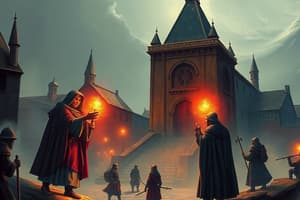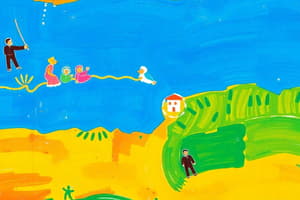Podcast
Questions and Answers
What is the capital city of Ireland?
What is the capital city of Ireland?
- Galway
- Cork
- Belfast
- Dublin (correct)
What ancient city was located in present-day Tunisia?
What ancient city was located in present-day Tunisia?
Carthage
Which island is known for its historical significance and was invaded by various empires?
Which island is known for its historical significance and was invaded by various empires?
Sicily
What is the largest island of Greece?
What is the largest island of Greece?
What city was the seat of the Byzantine Empire?
What city was the seat of the Byzantine Empire?
Which country is known for the Renaissance and a rich artistic heritage?
Which country is known for the Renaissance and a rich artistic heritage?
What is considered the city of seven hills and was the center of the Roman Empire?
What is considered the city of seven hills and was the center of the Roman Empire?
What body of water separates Italy from the Balkan Peninsula?
What body of water separates Italy from the Balkan Peninsula?
What island is located west of Italy and is known for its rugged coastline?
What island is located west of Italy and is known for its rugged coastline?
What is the French island located northeast of Sardinia?
What is the French island located northeast of Sardinia?
What river flows into the North Sea and is a major waterway in Germany?
What river flows into the North Sea and is a major waterway in Germany?
What is the body of water that connects Europe, Africa, and Asia?
What is the body of water that connects Europe, Africa, and Asia?
Which sea lies to the west of Italy and is a part of the Mediterranean?
Which sea lies to the west of Italy and is a part of the Mediterranean?
What continent is known for its historical developments and cultural diversity?
What continent is known for its historical developments and cultural diversity?
What continent is often referred to as the birthplace of Western civilization?
What continent is often referred to as the birthplace of Western civilization?
What sea is located south of Italy?
What sea is located south of Italy?
What empire was known for its influence during the Middle Ages in the Eastern Mediterranean region?
What empire was known for its influence during the Middle Ages in the Eastern Mediterranean region?
What mountain range runs down the spine of Italy?
What mountain range runs down the spine of Italy?
What river is famous for being crossed by Julius Caesar in 49 BC?
What river is famous for being crossed by Julius Caesar in 49 BC?
What mountain range forms a natural border between Italy and France?
What mountain range forms a natural border between Italy and France?
What was the name of the centralized European power during the medieval era?
What was the name of the centralized European power during the medieval era?
What major port city is located on the Elbe River in Germany?
What major port city is located on the Elbe River in Germany?
What mountain range is found in Eastern Europe, commonly known as the 'Carpathians'?
What mountain range is found in Eastern Europe, commonly known as the 'Carpathians'?
What river flows through central and eastern Europe and is one of the longest rivers in Europe?
What river flows through central and eastern Europe and is one of the longest rivers in Europe?
Flashcards are hidden until you start studying
Study Notes
Geographic Locations and Entities
- Ireland: An island nation located to the northwest of continental Europe, known for its rich culture and history.
- Carthage: An ancient city located in present-day Tunisia, known for its powerful naval empire and rivalry with Rome.
- Sicily: The largest island in the Mediterranean Sea, known for its strategic location and historical significance as a crossroads of cultures.
- Crete: The largest island in Greece, significant for its Minoan civilization and myths associated with ancient Greek culture.
- Constantinople: The capital of the Byzantine Empire, strategically located on the Bosporus Strait, serving as a bridge between Europe and Asia.
- Italy: A country located in Southern Europe, known for its rich historical heritage and the city of Rome, an ancient center of civilization.
- Rome: The capital city of Italy, known as the heart of ancient civilization and the seat of the Roman Catholic Church.
- Adriatic Sea: A body of water separating Italy from the Balkan Peninsula, significant for trade and cultural exchange.
- Sardinia: An Italian island located west of the mainland, known for its unique culture and ancient Nuragic civilization.
- Corsica: A French island in the Mediterranean Sea, notable for its mountainous terrain and as the birthplace of Napoleon Bonaparte.
- Elbe River: A major river in Central Europe, flowing through Germany and the Czech Republic, historically important for trade.
- Mediterranean Sea: A significant inland sea that has historically facilitated trade and cultural exchange between Europe, Africa, and Asia.
- Tyrrhenian Sea: Part of the Mediterranean Sea located west of Italy, known for its islands and historical maritime routes.
- Africa: The second-largest continent, home to diverse cultures and languages, with significant historical ties to Europe through trade and colonization.
- Europe: A continent known for its rich history, cultural diversity, and influence on global politics and economics.
- Ionian Sea: A body of water located between Italy and Greece, significant for maritime trade and cultural interactions.
Historical Empires and Geographic Features
- Byzantine Empire: The continuation of the Eastern Roman Empire, known for its preservation of classical knowledge and influence on Eastern Orthodox Christianity.
- Apennine Mountains: A major mountain range running down the backbone of Italy, influencing climate and settlement patterns.
- Rubicon River: An ancient river in Italy, famously crossed by Julius Caesar, symbolizing the point of no return in Roman politics.
- Alps: A significant mountain range in Europe, serving as a natural barrier and influencing cultural exchange between Italy and other European nations.
- Holy Roman Empire: A multi-ethnic complex of territories in Central Europe, recognized for its significant role in European politics during the medieval period.
- Hamburg: A major port city in northern Germany, historically important for trade and commerce in Europe.
- Carpathian Mountains: A mountain range in Central and Eastern Europe, known for its natural beauty and biodiversity.
- Genoa River: A historic river serving as a vital waterway for trade and transportation in Italy.
- Danube River: Europe's second-longest river, flowing through multiple countries, serving as a major trade route in history.
Studying That Suits You
Use AI to generate personalized quizzes and flashcards to suit your learning preferences.




